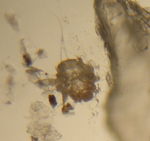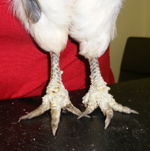Difference between revisions of "Knemidocoptes"
Jump to navigation
Jump to search
| Line 50: | Line 50: | ||
[[Category:Poultry]] | [[Category:Poultry]] | ||
[[Category:Burrowing_Mites]] | [[Category:Burrowing_Mites]] | ||
| − | [[Category:To_Do_- | + | [[Category:To_Do_-_NickJ]] |
Revision as of 19:14, 5 July 2010
Knemidocoptes are burrowing mites of avian species. There are a number of important species infecting both production birds and pet animals.
- Only genus of burrowing mites which occurs on avian species
- Life cycle similar to Sarcoptes spp.
Identification
Knemidocoptes are small round mites found in different locations on avian species dependant on the species of mite present. They have short legs as with most species of burrowing mite.
Detection
The method of detection is a combination of the presence of clinical signs as well as identification of mites on a skin scrape or feather pluck.
Life Cycle
- Repeat treatments with acaricides needed
- Few products licensed for use in poultry
Recognition
- Small, round mite
- Short legs
- U-shaped chitinous bar behind head
- Terminal anus
- K. mutans
- Scaly leg in poultry
- Mites burrow beneath leg scales causing them to loosen and rise
- Ragged appearance to legs and feet
- Distorted claws and feet
- Infected birds are usually lame
- K. gallinae
- Depluming itch in poultry
- Burrow into feather shafts
- Intense pain and pruritus
- Birds pull out body feathers
- K. pilae
- Scaly face and beak in psittacines
- Mites attack bare or lightly feathered areas of the face, beak, cere and body
- Scaliness at the base of the beak is the first sign which then spreads
- Little pruritus

